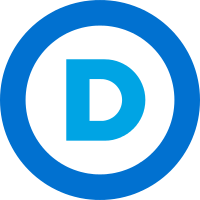Democratic Party (United States)
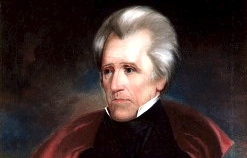
Democratic Party (Short History)
In which John Green teaches you where American politicians come from. In the beginning, soon after the US constitution was adopted, politics were pretty non-existent. George Washington was elected president with no opposition, everything was new and exciting, and everyone just got along. For several months. Then the contentious debate about the nature of the United States began, and it continues to this day. Washington and his lackey/handler Alexander Hamilton pursued an elitist program of federalism. They attempted to strengthen the central government, create a strong nation-state, and leave less of the governance to the states, They wanted to create debt, encourage manufacturing, and really modernize the new nation/ The opposition, creatively known as the anti-federalists, wanted to build some kind of agrarian pseudo-paradise where every (white) man could have his own farm, and live a free, self-reliant life. The founding father who epitomized this view was Thomas Jefferson. By the time Adams became president, the anti-federalists had gotten the memo about how alienating a name like anti-federalist can be. It’s so much more appealing to voters if your party is for something rather than being defined by what you’re against, you know? In any case, Jefferson and his acolytes changed their name to the Democratic-Republican Party, which covered a lot of bases, and proceeded to protest nearly everything Adams did. Lest you think this week is all boring politics,you’ll be thrilled to hear this episode has a Whiskey Rebellion, a Quasi-War, anti-French sentiment, some controversial treaties, and something called the XYZ Affair, which sounds very exciting. Learn all about it this week with John Green.
The Democratic Party of the United States of America is one of the two major contemporary political parties in the United States, along with the younger Republican Party. Tracing its origins back to the Democratic-Republican Party, the modern Democratic Party was founded around 1828 and is the oldest political party in the world. There have been 15 Democratic presidents, the first being Andrew Jackson, who served from 1829 to 1837; the most recent is the current president, Barack Obama, who has served since 2009.
Since the 1930s, the party has promoted a social liberal platform. Until the late 20th century the party had a powerful conservative wing based in the rural South, which over time has greatly diminished. Today its Congressional caucus is composed mostly of progressives and centrists.
As of the 113th Congress, following the 2012 elections, the Democratic Party currently holds a minority of seats in the House of Representatives and a majority of seats in the United States Senate, as well as a minority of state governorships and control of a minority of state legislatures.
History of the United States Democratic Party
 Andrew Jackson is typically considered the first Democratic President of the United States
Andrew Jackson is typically considered the first Democratic President of the United States
The Democratic Party evolved from the Jeffersonian Republican or Democratic-Republican Party organized by Thomas Jefferson and James Madison in opposition to the Federalist party of Alexander Hamilton and John Adams. The party favored republicanism, a weak federal government, states’ rights, agrarian interests (especially Southern planters) and strict adherence to the Constitution; it opposed a national bank, close ties to Great Britain, and business and banking interests. The Party came to power in the election of 1800.
After the War of 1812, the Federalists virtually disappeared and the Jeffersonian party split into factions. They split over the choice of a successor to President James Monroe, and the party faction that supported many of the old Jeffersonian principles, led by Andrew Jackson and Martin Van Buren, became the Democratic Party. Other factions led by Henry Clay helped form the Whig Party. The Democratic Party had a small advantage over the Whigs until the 1850s, when the Whigs fell apart over the issue of slavery. In 1854, angry with the Kansas–Nebraska Act, anti-slavery Democrats left the party and joined Northern Whigs to form the Republican Party.
1860
The Democrats split over the choice of a successor to President James Buchanan along Northern and Southern lines; factions of the party provided two separate candidacies for President in the election of 1860, in which the Republican Party gained ascendancy. Southern Democrats, after some delegates followed the lead of the Fire-Eaters by walking out of the Democratic convention at Charleston‘s Institute Hall in April 1860, and were subsequently joined by those who, once again led by the Fire-Eaters, left the Baltimore Convention the following June when the convention would not adopt a resolution supporting extending slavery into territories whose voters did not want it, nominated the pro-slavery incumbent Vice-President, John C. Breckinridge of Kentucky, for President and General Joseph Lane, former Governor of Oregon, for Vice President. The Northern Democratsproceeded to nominate Senator Stephen A. Douglas of Illinois for President and former Governor of Georgia Herschel V. Johnsonfor Vice-President, while some southern Democrats joined the Constitutional Union Party, backing its nominees (who had both been prominent Whig leaders), former Senator, Speaker of the House, and Secretary of War John Bell of Tennessee for President and the politician, statesman, and educator Edward Everett of Massachusetts for Vice-President. This fracturing of the Democrats led to a Republican victory, and Abraham Lincoln was elected the 16th President of the United States.
As the American Civil War broke out, Northern Democrats were divided into War Democrats and Peace Democrats. The Confederate States of America, whose political leadership, mindful of the welter prevalent in antebellum American politics and with a pressing need for unity, largely viewed political parties as inimical to good governance; consequently the Confederacy had none, or at least none with the wide organization inherent to other American parties. Most War Democrats rallied to Republican President Abraham Lincoln and the Republicans’ National Union Party in the election of 1864, which featured Andrew Johnson on the Republican ticket even though he was a Democrat from the South. Johnson replaced Lincoln in 1865 but stayed independent of both parties. The Democrats benefited from white Southerners’ resentment of Reconstruction after the war and consequent hostility to the Republican Party. After Redeemers ended Reconstruction in the 1870’s, and following the often extremely violent disenfranchisement of African Americans led by such white supremacist Democratic politicians as Benjamin Tillman of South Carolina in the 1880’s and 1890’s, the South, voting Democratic, became known as the “Solid South.” Though Republicans won all but two presidential elections, the Democrats remained competitive. The party was dominated by pro-business Bourbon Democratsled by Samuel J. Tilden and Grover Cleveland, who represented mercantile, banking, and railroad interests; opposed imperialismand overseas expansion; fought for the gold standard; opposed bimetallism; and crusaded against corruption, high taxes, and tariffs. Cleveland was elected to non-consecutive presidential terms in 1884 and 1892.
1900
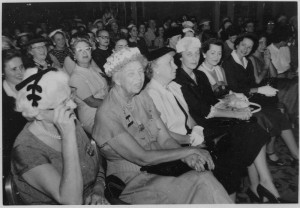 Eleanor Roosevelt at the Democratic National Convention in Chicago, 1956
Eleanor Roosevelt at the Democratic National Convention in Chicago, 1956
Agrarian Democrats demanding Free Silver overthrew the Bourbon Democrats in 1896 and nominated William Jennings Bryan for the presidency (a nomination repeated by Democrats in 1900 and 1908). Bryan waged a vigorous campaign attacking Eastern moneyed interests, but he lost to Republican William McKinley. The Democrats took control of the House in 1910 and elected Woodrow Wilson as president in 1912 and 1916. Wilson effectively led Congress to put to rest the issues of tariffs, money, and antitrust that had dominated politics for 40 years with new progressive laws. The Great Depression in 1929 that occurred under Republican President Herbert Hoover and the Republican Congress set the stage for a more liberal government; the Democrats controlled the House of Representatives nearly uninterrupted from 1931 until 1995 and won most presidential elections until 1968. Franklin D. Roosevelt, elected to the presidency in 1932, came forth with government programs called the New Deal. New Deal liberalism meant the promotion of social welfare, labor unions, civil rights, and regulation of business. The opponents, who stressed long-term growth, support for business, and low taxes, started calling themselves “conservatives.”
Modern Era
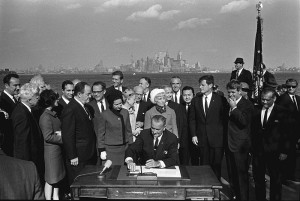 President Lyndon B. Johnson signs the Immigration Act of 1965 as Sen. Edward Kennedy, Sen. Robert Kennedy, and others look on.
President Lyndon B. Johnson signs the Immigration Act of 1965 as Sen. Edward Kennedy, Sen. Robert Kennedy, and others look on.
Issues facing parties and the United States after World War II included the Cold War and the Civil Rights Movement. Republicans attracted conservatives and white Southerners from the Democratic coalition with their use of the Southern strategy and resistance to New Deal and Great Society liberalism. African Americans had traditionally supported the Republican Party because of the anti-slavery agenda of Abraham Lincoln and successors such as Ulysses Grant. But they began supporting Democrats following the ascent of the Franklin Roosevelt administration, the New Deal, the integration of the military and embrace of proposed civil rights legislation by President Harry Truman in 1947–48, and the postwar Civil Rights movement. The Democratic Party’s main base of support shifted to the Northeast, marking a dramatic reversal of history. Bill Clinton was elected to the presidency in 1992, governing as a New Democrat. The Democratic Party lost control of Congress in the election of 1994 to the Republican Party. Re-elected in 1996, Clinton was the first Democratic President since Franklin Roosevelt to be elected to two terms. Following twelve years of Republican rule, the Democratic Party regained majority control of both the House and the Senate in the 2006 elections. Some of the party’s key issues in the early 21st century in their last national platform have included the methods of how to combat terrorism, homeland security, expanding access to health care, labor rights, environmentalism, and the preservation of liberal government programs. In the 2010 elections, the Democratic Party lost control of the House, but kept a small majority in the Senate (reduced from the 111th Congress). It also lost its majority in state legislatures and state governorships. However, the 2012 elections which re-elected President Obama represented a partial reversal of the results of the 2010 midterm vote, increasing the Democratic majority in the Senate and reducing the Republican majority in the House.
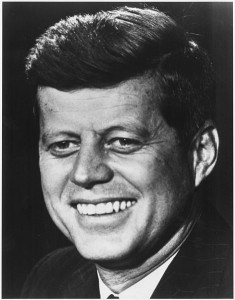 John F. Kennedy, 35thPresident of the United States (1961–1963)
John F. Kennedy, 35thPresident of the United States (1961–1963)
The Democratic Party traces its origins to the inspiration of the Democratic-Republican Party, founded by Thomas Jefferson, James Madison, and other influential opponents of the Federalists in 1792. That party also inspired the Whigs and modern Republicans. Organizationally, the modern Democratic Party truly arose in the 1830s, with the election of Andrew Jackson. Since the division of the Republican Party in the election of 1912, it has gradually positioned itself to the left of the Republican Party on economic and social issues.
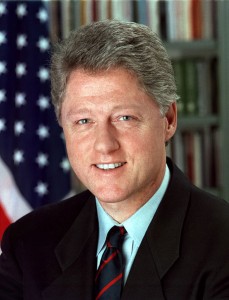 Bill Clinton, 42nd President of the United States (1993–2001)
Bill Clinton, 42nd President of the United States (1993–2001)
Until the period following the passage of the Civil Rights Act of 1964—which was championed by a Democratic president but faced lower Democratic than Republican support in Congress—the Democratic Party was primarily a coalition of two parties divided by region. Southern Democrats were typically given high conservative ratings by the American Conservative Union while northern Democrats were typically given very liberal ratings. Southern Democrats were a core bloc of the bipartisan conservative coalition which lasted through the Reagan-era. The economically activist philosophy of Franklin D. Roosevelt, which has strongly influenced American liberalism, has shaped much of the party’s economic agenda since 1932, and served to tie the two regional factions of the party together until the late 1960s. In fact, Roosevelt’s New Deal coalition usually controlled the national government until the 1970’s.
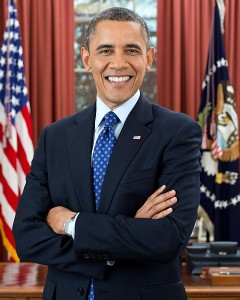 Barack Obama, 44th President of the United States (2009-present)
Barack Obama, 44th President of the United States (2009-present)
Based on a series of polls conducted in 2010, Gallup found that 31% of Americans identified as Democrats, 29% as Republicans, and 38% as Independents. A similar series of polls conducted in 2011 found the percentage of Democrats to be the same at 31%, while a two percentile-point rise in the number of Independents, to an all-time high of 40%, appeared to stem from an equal drop in the number of those Americans identifying themselves as Republicans from the previous poll, to 27%. A Pew Research Center survey of registered voters released August 2010 stated that 47% identified as Democrats or leaned towards the party; the same poll found that 43% of registered voters identified as Republicans or leaned towards the Republican party.
Name and Symbols
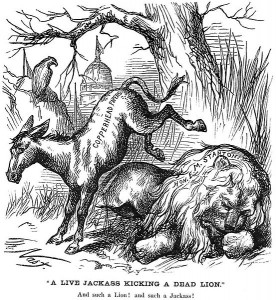 “A Live Jackass Kicking a Dead Lion” by Thomas Nast. Harper’s Weekly, January 19, 1870.
“A Live Jackass Kicking a Dead Lion” by Thomas Nast. Harper’s Weekly, January 19, 1870.
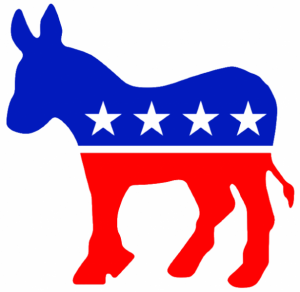 The donkey party logo is still a well-known symbol for the Democratic Party, despite not being the official logo of the party.
The donkey party logo is still a well-known symbol for the Democratic Party, despite not being the official logo of the party.
Initially calling itself the “Republican Party,” Jeffersonians were labeled “Democratic” by the opposition Federalists, with the hope of stigmatizing them as purveyors of democracy or mob rule. By the Jacksonian era, the term “The Democracy” was in use by the party; the name “Democratic Party” was eventually settled upon and became the official name in 1844.
The term “Democrat party” has also been in local use but has usually been used by opponents since 1952 as an epithet.
The most common mascot symbol for the party has been jackass or the donkey.[25]Andrew Jackson’s enemies twisted his name to “jackass” as a term of ridicule regarding a stupid and stubborn animal. However the Democrats liked the common-man implications and picked it up too, so the image persisted and evolved. Its most lasting impression came from the cartoons of Thomas Nast 1870 in Harper’s Weekly. Cartoonists followed Nast and used the donkey to represent the Democrats, and the elephant to represent the Republicans.
In the early 20th century, the traditional symbol of the Democratic Party in Midwestern states such as Indiana, Kentucky, Oklahoma and Ohio was the rooster, as opposed to the Republican eagle. This symbol still appears on Oklahoma, Kentucky, Indiana, and West Virginia ballots. In New York, the Democratic ballot symbol is a five-pointed star. For the majority of the 20th century, Missouri Democrats used the Statue of Liberty as their ballot emblem. This meant that when Libertarian candidates receivedballot access in Missouri in 1976, they could not use the Statue of Liberty, their national symbol, as the ballot emblem. Missouri Libertarians instead used the Liberty Bell until 1995, when the mule became Missouri’s state animal. From 1995 to 2004, there was some confusion among voters, as the Democratic ticket was marked with the Statue of Liberty (used by Libertarians in other states) and the Libertarians’ mule was easily mistaken for a Democratic donkey.
Although both major political parties (and many minor ones) use the traditional American red, white, and blue colors in their marketing and representations, since election night 2000 the color blue has become the identified color of the Democratic Party, while the color red has become the identified color of the Republican Party. That night, for the first time, all major broadcast television networks used the same color scheme for the electoral map: blue states for Al Gore (Democratic nominee) and red states for George W. Bush (Republican nominee). Since then, the color blue has been widely used by the media to represent the party. This has caused confusion among non-American observers because blue is the traditional color of the right and red the color of the left outside of the United States. For example, in Canada red represents the Liberals, while blue represents the Conservatives. In the United Kingdom, red denotes the Labour Party and blue symbolizes the Conservative Party. Blue has also been used both by party supporters for promotional efforts — ActBlue, BuyBlue, BlueFund, as examples — and by the party itself in 2006 both for its “Red to Blue Program”, created to support Democratic candidates running against Republican incumbents in the midterm elections that year, and on its official website.
In September, 2010, the Democratic Party unveiled its new logo, which featured a blue D inside a blue circle. It was the party’s first official logo, as the donkey logo had only been semi-official.
Jefferson-Jackson Day is the annual fundraising event (dinner) held by Democratic Party organizations across the United States. It is named after Presidents Thomas Jefferson and Andrew Jackson, whom the party regards as its distinguished early leaders.
The song “Happy Days Are Here Again” is the unofficial song of the Democratic Party. It was used prominently when Franklin D. Roosevelt was nominated for president at the 1932 Democratic National Convention and remains a sentimental favorite for Democrats today. For example, Paul Shaffer played the theme on the Late Show with David Letterman after the Democrats won Congress in 2006. More recently, “Don’t Stop” by Fleetwood Mac was adopted by Bill Clinton‘s presidential campaign in 1992, and has endured as a popular Democratic song. Also, the emotionally similar song “Beautiful Day” by the band U2 has become a favorite theme song for Democratic candidates. John Kerry used the song during his 2004 presidential campaign, and several Democratic Congressional candidates used it as a celebratory tune in 2006. Aaron Copland‘s Fanfare for the Common Man is traditionally performed at the beginning of the Democratic National Convention.
http://en.wikipedia.org/wiki/Democratic_Party_(United_States)

